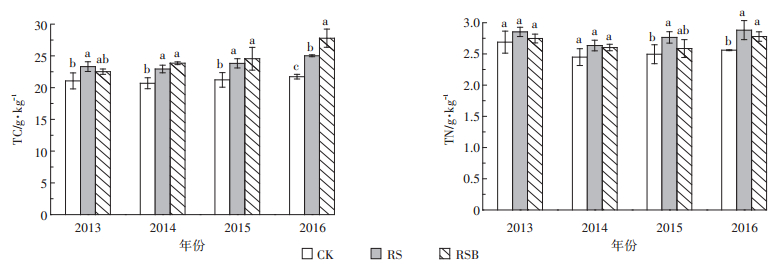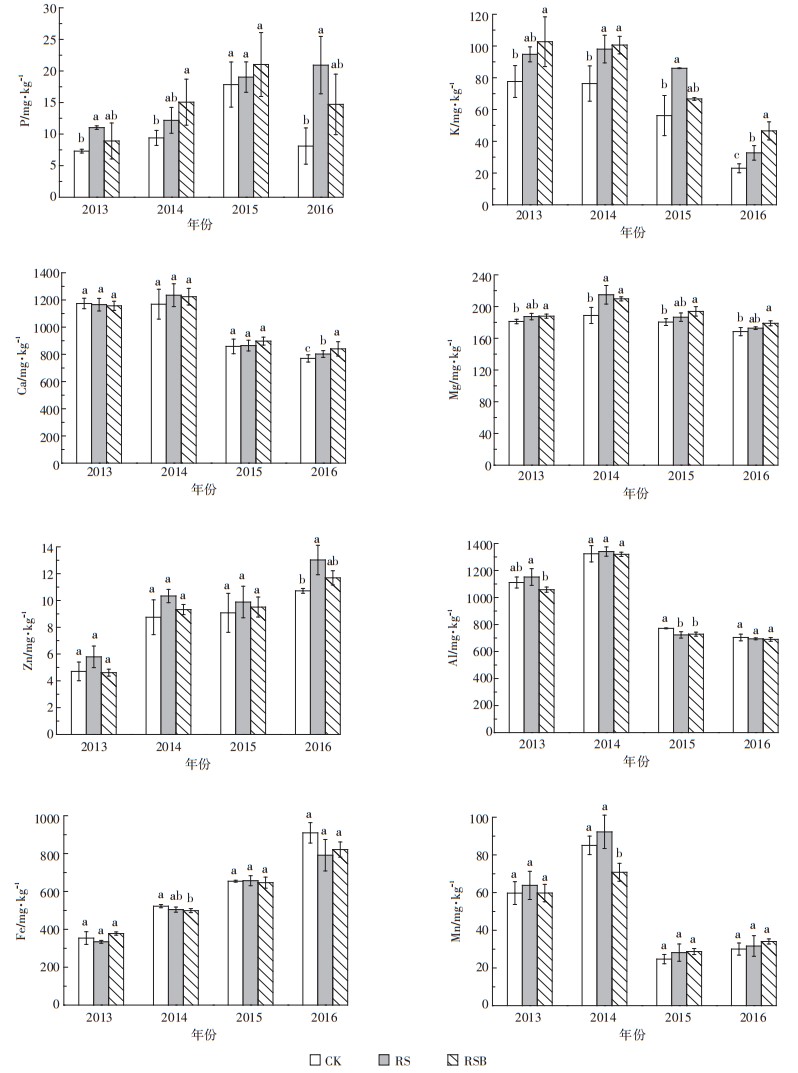2. 浙江农林大学环境与资源学院, 杭州 311300
2. School of Environmental & Resource Sciences, Zhejiang A & F University, Hangzhou 311300, China
中国是世界上水稻种植面积最广的国家,每年产生的水稻秸秆量高达2亿多t[1]。水稻秸秆富含氮、磷、钾等营养元素,被认为是一种丰富的可再生资源[2]。农业部推广的秸秆直接还田虽能促进养分循环、减少化肥施用、提升农作物产量[3],然而也会促进稻田温室气体甲烷的大量排放,长期还田还会导致稻田病虫害以及僵苗等现象发生[4-5]。
生物质炭(Biochar)是生物质在缺氧条件下低温热解产生的高度芳香化物质,具有高pH、高碳含量与较强的阳离子交换能力、较大的比表面积和丰富的营养元素含量等优良特性,目前越来越多地被应用于土壤改良和作物增产[6-7]。研究发现,水稻秸秆生物质炭化还田具有提高水稻产量、提升土壤碳库储备以及减少稻田温室气体排放等作用,是替代秸秆直接还田的理想措施[8-16]。然而关于水稻秸秆生物质炭化还田对水稻产量和土壤养分的影响研究基本采用一次性、高剂量(高于等剂量,等剂量=秸秆产量×炭化得率)的还田模式[8-11],未曾有单季稻作制下,连续的等量水稻秸秆炭化还田对水稻产量和土壤养分的影响研究。而且,在一次性高剂量还田模式下,水稻秸秆生物质炭对水稻产量的提高会随着还田时间的延长而减弱[8-10]。此外,受水稻生长季节性、单位面积秸秆产量和秸秆生物质炭化得率等因素的限制,生产实践过程中稻田不可能普遍实施基于秸秆资源异位转移方式的高剂量炭化还田模式。因此,若在稻田生态系统中采用逐年全量秸秆生物质炭化还田模式,即逐年将产生的水稻秸秆生物质全量炭化后原位还田,既能实现秸秆资源的完全利用,又能不断向稻田补充生物质炭,维持其营养水平,理论上将比一次性高剂量还田模式更有应用前景。
为探究逐年全量秸秆生物质炭化还田模式在实际生产中对稻田增产和土壤改良的持续效应,本文拟选择浙江省北部一处多年种植单季稻的中产稻田进行4年的定位试验,每年定期测定水稻株高和籽粒产量及土壤pH、CEC、TC、TN、有效态P、K、Ca、Mg等营养元素含量,并在此基础上探究秸秆生物质炭对土壤养分和水稻产量的影响机理,旨在为我国开发和应用秸秆炭化还田技术提供理论和实践依据。
1 材料和方法 1.1 试验地概况和实验材料选择浙江省杭州市余杭区(30°22′N,119°51′E)一处多年种植单季稻的水田作为试验田,根据中国土壤数据库的分类,试验田土种是泥质田,以黏壤土为主。气候为典型的亚热带季风气候,年平均气温17.2 ℃,年均降雨量1490 mm。本实验所采用的生物质炭是以水稻秸秆为原料,切碎至粒径5 mm后经自制的自燃内热式炭化炉在450~500 ℃下高温裂解2 h制成。实验采用的土壤、水稻秸秆和秸秆生物质炭的基本理化性质如表 1所示。
|
|
表 1 供试土壤、水稻秸秆和秸秆生物质炭的基本理化性质 Table 1 Properties of soil, rice straw and rice straw-derived biochar in the study |
试验期为2013年7月至2016年11月,采用水稻单季的种植方式,每年水稻7月初移栽,11月底收获。共设三个处理:CK:对照(无任何水稻秸秆和生物质炭还田);RS:水稻秸秆全量还田(8 t·hm-2);RSB:全量秸秆生物质炭化还田[2.8 t·hm-2水稻秸秆生物质炭=8 t·hm-2水稻秸秆×0.35(炭化炉炭化得率)]。每个处理设置3个重复区块,共计9个区块,每个区块的面积是:4 m×5 m=20 m2。在每年耕种前对各区块修建田埂,并用薄膜包被,防止串水。切碎后的秸秆(5 mm)和秸秆生物质炭在每年水稻移栽前分别施入耕作层(15 cm),常规翻土混匀后淹水。水稻品种为粳稻秀水134(Oryza sativa L),采用秧苗移栽的方式,控制每个区块秧苗数量一致。稻田采用前期淹水,后期涝干的常规管理方式。各处理按照传统施肥方法施加等量化肥,分别是氮肥(以纯N计)270 kg·hm-2,磷肥(以P2O5计)75 kg·hm-2,钾肥(以K2O计)90 kg·hm-2。其中氮肥类型为尿素,以基肥、分蘖肥和穗肥按照4:3:3的比例输入。磷肥和钾肥为过磷酸钙和氯化钾,以基肥的形式一次性施入。
1.3 试验样品的采集、处理及指标测定在2013—2016年期间,每年收获期测定水稻株高和籽粒产量。在每个小区内随机取6株水稻测量株高,实测每个小区内所有水稻植株的籽粒产量并换算成每公顷产量。
同时,采集根际土壤,自然条件下风干后过2 mm筛,装入塑封袋用于pH、CEC及有效态P、K、Ca、Mg、Zn、Fe、Al和Mn(以下简称M3-P、K等)等营养元素的测定。其中,采用pH电位计(Seven Compact,METTLER TOLEDO,Switzerland)测定土壤pH(土:水质量体积比为1:2.5);土壤和秸秆生物质炭的CEC采用氯化钡平衡法测得,有效态营养元素采用Mehlich3提取液提取,电感耦合等离子发射光谱仪(ICP)仪和钼锑抗比色法测定[17],具体测量方法参照文献[8]。
此外,将风干土磨细过100目筛后采用元素分析仪(Flash EA1112,ThermoFinnigan,Italy)测定TC、TN含量。
1.4 数据处理和分析数据经Excel 2013预处理后用SPSS 20.0单因素方差分析(One-way ANOVA)中的最小显著性差异法(LSD)分析进行处理间各项指标的显著性差异检验,P < 0.05视为统计学上具有显著性差异。运用SPSS 20.0软件对水稻四年平均产量、pH、CEC和土壤养分含量进行Pearson相关性分析。
2 结果与分析 2.1 对水稻株高和籽粒产量的影响从表 2可看出,与CK相比,RSB和RS均能促进水稻生长和产量的提高(P < 0.05),其中RSB第一年增产7.6%,第二年增产10.6%,第三、第四年分别增产14.5%和9.7%,平均每年增产10.7%。RS第1~4年分别增产5.2%、10.5%、15.5%、7.0%,平均每年增产9.6%。除了2015年,其他年份RSB对株高和产量的增幅均大于RS。
|
|
表 2 全量秸秆炭化还田对水稻株高和籽粒产量的影响 Table 2 Effects of biochar application on rice height and grain yield |
土壤pH和CEC是重要的土壤化学指标,pH可以影响土壤养分元素的形态,CEC可以评价土壤保肥能力。与CK相比,RSB和RS对pH平均每年增加0.13和0.04个单位,对CEC平均增加0.14、0.07 cmol·kg-1(表 3)。由于添加量小,土壤酸性强,缓冲作用大,RSB对土壤pH的影响并不显著。
|
|
表 3 全量秸秆炭化还田对土壤pH和CEC的影响 Table 3 Effects of biochar application on soil pH and CEC |
2013—2016年,RSB和RS均能持续提高稻田土壤TC含量(图 1),其中RSB第1~4年的增幅分别为6.91%、15.23%、12.69%、27.89%,RS第1~4年的增幅分别为10.68%、10.84%、12.28%、15.18%。4年内,RSB和RS对土壤TC含量的年均增量分别为3.05 g· kg-1和2.50 g · kg-1,年均增幅分别为15.77%和11.81%。而在试验持续第4年,RSB的土壤TC含量从第一年的22.51 g·kg-1提升到了27.78 g·kg-1,已显著高于CK与RS(P < 0.05),因此从4年的综合效应来看,RSB的累积作用比RS更明显。

|
图 1 全量秸秆炭化还田对稻田土壤TC和TN的影响 Figure 1 Effects of biochar addition on the paddy soil TC and TN contents |
同样,RSB和RS也能持续提高稻田土壤TN含量(图 1),4年内RSB和RS对土壤TN含量的年均增量分别为0.13 g·kg-1和0.24 g·kg-1,年均增幅分别为5.12%和9.24%,小于土壤TC的增幅。此外,从4年的综合效应来看,RSB和RS可以实现土壤TN的显著累积(P < 0.05),第4年RSB与RS与CK相比分别增加了8.56%和12.58%。
2.4 对稻田土壤有效态营养元素含量的影响P、K、Ca、Mg、Zn、Fe和Mn是植物生长的必需营养元素,但是土壤Fe和Mn元素过量会对水稻产生毒害作用,而Al是酸性土壤中抑制植物生长的主要因素之一。因此,土壤速效养分的丰缺程度与水稻产量息息相关。
由图 2可知,与CK相比,RSB和RS均能持续提高土壤M3-P、K、Mg、Ca含量,RSB和RS对M3-P、K、Mg、Ca平均增幅分别为40.0%、37.0%、5.6%、3.7%和48.1%、31.2%、4.4%、2.4%。但是,RSB和RS对某些土壤营养元素含量的影响程度存在差异。比如,在试验第4年,RSB的M3-K、Ca含量显著高于RS(P < 0.05)。

|
图 2 全量秸秆炭化还田对稻田土壤M3-P、K、Ca、Mg、Al、Fe、Mn和Zn的影响 Figure 2 Effects of biochar addition on the paddy soil M3-P, K, Ca, Mg, Al, Fe, Mn and Zn contents |
此外,与CK相比,RSB能够显著降低土壤M3- Al、Fe、Mn含量(P < 0.05)。RSB在试验第3年显著降低了M3-Al含量(P < 0.05),在试验第2年显著降低了M3-Fe、Mn含量(P < 0.05)。与RS相比,RSB在试验第1年显著降低了M3-Al含量(P < 0.05)。
3 讨论 3.1 全量秸秆炭化还田对土壤养分的影响及其机理4年田间试验表明,RSB能明显提高土壤TC、TN(图 1)、有效态P、K、Ca、Mg含量(图 2)。秸秆生物质炭还田对土壤养分的提高作用,可能有以下两方面的原因:一是秸秆生物质炭直接输入导致其携带的养分进入土壤,二是秸秆生物质炭本身促进了土壤养分的累积。为考察秸秆生物质炭对土壤养分的影响机理,假设试验土壤容重为1.0 g·cm-3[18-20],耕层土厚度为15 cm。按照全量秸秆生物质炭还田量2.8 t·hm-2可估算出RSB每年向土壤中添加的TC、TN分别为1.00 g·kg-1和0.02 g·kg-1,添加的M3-P、K、Mg、Ca分别为2.24、6.16、2.99 mg·kg-1和6.16 mg·kg-1。由图 1和图 2可知,RSB对土壤TC、TN的增量分别为3.05 g·kg-1和0.13 g·kg-1,对M3-P、K、Ca、Mg的增量分别为4.66、21.61、10.29、36.80 mg·kg-1。秸秆生物质炭自身携带的TC、TN和速效P、K、Ca、Mg对土壤养分的增加贡献率分别为30.3%、15.3%、48.07%、28.50%、29.06%、16.74%,均不足50%。这表明,土壤养分的提高更大程度上是由于秸秆生物质炭间接增强了土壤碳氮元素及速效养分的累积。
目前,已有大量文献报道了生物质炭输入对土壤有机碳形成负激发效应[21-25]。其机理可能为:(1)生物质炭与黏土矿物结合,提高土壤团聚体稳定性,减缓有机质的分解[21-23];(2)生物质炭改变微生物群落结构,使微生物碳代谢效率降低[23-25]。此外,4年的定位试验表明秸秆生物质炭添加能够促进水稻生长(表 2),因此推测水稻根系向土壤分泌的“新碳”增多。考虑到本试验中土壤M3-Al、Fe含量丰富(图 2),这些“新碳”会受到土壤团聚体的保护形成铁铝氧化物结合态而稳定下来[26]。值得注意的是,RS虽然同样能够促进土壤TC的累积,但是累积效果却不如RSB。这可能是因为,秸秆中大分子有机物在土壤中易腐解成小分子有机物,进而被微生物降解转化为CH4和CO2,排放到大气中。但是,秸秆生物质炭的碳以稳定的芳环结构存在[27],不易矿化。
同时,一些文献表明,生物质炭主要是通过提高土壤对铵氮的吸附能力[28],减少稻田氧化亚氮排放[29]和氨挥发[30],增加土壤固氮微生物种类和数量[31]来促进土壤氮素的固定。
关于生物质炭本身提高土壤速效养分P、K、Ca、Mg含量的机理可能是:(1)秸秆生物质炭具有巨大的比表面积和丰富的孔隙结构以及大量带负电荷的-COOH、-COH、-OH等含氧官能团,能吸附土壤营养元素、提高土壤持水性,从而减少养分流失[32];(2)添加生物质炭影响了土壤微生物对养分的循环过程,促进土壤有效态P、K的生成[33];(3)添加生物质炭能提高土壤pH(表 3),有研究表明随着土壤pH的升高,有效态P、K含量增加[34]。不同于秸秆生物质炭还田,秸秆直接还田对土壤速效养分的提高与秸秆腐解有关。秸秆腐解一方面释放携带的营养元素,另一方面生成小分子有机物质与土壤矿物反应,促进土壤本身养分的释放[35]。
此外,从图 2可知,秸秆生物质炭添加可以降低土壤M3-Al、Fe、Mn含量,这可能与土壤pH及TC含量升高有关。从表 2可知,RSB对土壤pH提高的平均幅度为0.13个单位。土壤pH升高使有效态Al、Fe、Mn形态发生变化,变成难溶性的氢氧化物或氧化物沉淀[36-38]。同时,有文献表明生物质炭会促进土壤生成大量胡敏酸[39]。胡敏酸的分子量大,聚合度高,与铝铁锰络合成盐类,使铝铁锰活性降低[40]。
3.2 水稻产量与土壤养分的内在联系进一步将水稻籽粒4年平均产量和pH、CEC及其他养分含量的4年平均值做相关性分析(图 3)。Pearson相关系数表明水稻产量和土壤TC、M3-K、Mg含量呈极显著正相关关系(P < 0.01),和TN、M3-Al含量分别呈显著正相关和负相关关系(P < 0.05)。有文献指出,土壤微生物量碳(MBC)、微生物量氮(MBN)分别与土壤TC、TN呈极显著正相关关系[41],RSB和RS能明显提高土壤TC、TN含量(图 1),从而促进土壤MBC、MBN的提高。MBC、MBN是土壤有机质的重要活性组分,参与土壤养分转化和循环的各个过程,对植物养分吸收和生长发育具有积极影响。当土壤K < 110 mg·kg-1时(Mehlich3通用浸提法),属于严重缺K的状态[42]。本试验地测得的土壤有效K为77.6 mg·kg-1,明显 < 110 mg·kg-1。秸秆生物质炭还田能明显提高土壤有效K的含量(图 2),缓解土壤K的亏缺,促进水稻生长。因此,RSB增产的关键因素是土壤TC、TN、有效K、Mg含量的提高及有效Al含量的减少。此外,RSB比RS增产效果更明显的原因可能是对土壤TC、M3-K、Mg含量及有效Al含量的影响效率更高。

|
图 3 水稻产量、土壤pH、CEC及营养元素之间的相关性矩阵 Figure 3 Correlation matrices among rice yield, soil pH, CEC and soil nutrients from paddy soil |
与一次性高剂量还田模式相比,逐年全量秸秆生物质炭化还田模式能维持较高水平的增产效应。试验开展的4年间,RSB对水稻产量的增幅在7.6%~ 14.5%之间,平均增产10.7%(表 2)。而在同一气候和地形水平下,一次性施用22.5 t·hm-2水稻秸秆生物质炭在还田第2~5年只分别增产6.1%、2.2%、2.9%、3.1%[8]。这主要是由于在一次性高剂量还田模式后期,生物质炭在土壤中发生纵向迁移,且吸附位点渐趋饱和,于是表层土壤速效养分含量不再提高,水稻增产减弱。相反,逐年全量秸秆生物质炭化还田模式能不断为土壤补充养分,并提供新的吸附位点,增强土壤自身固定养分的能力,使水稻产量维持在较高水平。事实证明,逐年全量秸秆生物质炭化还田持续增产增肥效果显著,是稻田生态系统极具潜力的秸秆资源利用模式。
4 结论(1)全量秸秆炭化还田能显著提高水稻株高和籽粒产量,且增幅大于秸秆直接还田。
(2)全量秸秆炭化还田能明显提高稻田土壤TC、TN、有效态P、K、Mg、Ca含量,降低土壤过量的有效Al、Fe、Mn含量。
(3)全量秸秆炭化还田对土壤养分的提高更大程度上是由于秸秆生物质炭本身增强了土壤固定C、N及速效养分的能力。
(4)全量秸秆炭化还田对水稻增产的关键因素是土壤TC、TN和有效K、Mg含量的提高以及土壤有效Al含量的降低。
| [1] |
彭春艳, 罗怀良, 孔静. 中国作物秸秆资源量估算与利用状况研究进展[J]. 中国农业资源与区划, 2014(3): 14-20. PENG Chun-yan, LUO Huai-liang, KONG Jing. Advance in estimation and utilization of crop residues resources in China[J]. Chinese Journal of Agricultural Resources and Regional Planning, 2014(3): 14-20. |
| [2] |
高祥照, 马文奇, 马常宝, 等. 中国作物秸秆资源利用现状分析[J]. 华中农业大学学报, 2002, 21(3): 242-247. GAO Xiang-zhao, MA Wen-qi, MA Chang-bao, et al. Analysis on the current status of utilization of crop straw in China[J]. Journal of Huazhong Agricultural University, 2002, 21(3): 242-247. DOI:10.3321/j.issn:1000-2421.2002.03.012 |
| [3] |
毕于运.秸秆资源评价与利用研究[D].北京: 中国农业科学院, 2010: 141. BI Yu-yun. Study on straw resources evalucation and utilization in China[D]. Beijing: Chinese Academy of Agricultural Sciences, 2010: 141. http://cdmd.cnki.com.cn/Article/CDMD-82101-2010170789.htm |
| [4] |
Qi Y Z, Zhen W C, Li H Y. Allelopathy of decomposed maize straw products on three soil-born diseases of wheat and the analysis by GCMS[J]. Journal of Integrative Agriculture, 2015, 14(1): 88-97. DOI:10.1016/S2095-3119(14)60795-4 |
| [5] |
徐华, 蔡祖聪, 贾仲君, 等. 前茬季节稻草还田对稻田CH4排放的影响[J]. 农业环境保护, 2001, 20(5): 289-292. XU Hua, CAI Zu-cong, JIA Zhong-jun, et al. Effect of rice straw application time in previous crop season on CH4 emission from rice paddy field[J]. Agro-environmental Protection, 2001, 20(5): 289-292. |
| [6] |
Liang B, Lehmann J, Solomon D, et al. Black carbon increases cation exchange capacity in soil[J]. Soil Science Society of America Journal, 2006, 70(5): 1719-1730. DOI:10.2136/sssaj2005.0383 |
| [7] |
袁金华, 徐仁扣. 生物质炭的性质及其对土壤环境功能影响的研究进展[J]. 生态环境学报, 2011, 20(4): 779-785. YUAN Jin-hua, XU Ren-kou. Progress of the research on the properties of biochars and their influence on soil environmental functions[J]. Ecology and Environmental Sciences, 2011, 20(4): 779-785. DOI:10.3969/j.issn.1674-5906.2011.04.034 |
| [8] |
董达.生物质炭对水稻生长与稻田甲烷排放效应的影响及其机理研究[D].杭州: 浙江大学, 2015: 18-31. DONG Da. Effects of biochar amendment on rice growth and methane emission from paddy field[D]. Hangzhou: Zhejiang University, 2015: 18-31. http://cdmd.cnki.com.cn/Article/CDMD-10335-1016054628.htm |
| [9] |
Liu Y, Lu H, Yang S, et al. Impacts of biochar addition on rice yield and soil properties in a cold waterlogged paddy for two crop seasons[J]. Field Crops Research, 2016, 191: 161-167. DOI:10.1016/j.fcr.2016.03.003 |
| [10] |
Dong D, Yang M, Wang C, et al. Responses of methane emissions and rice yield to applications of biochar and straw in a paddy field[J]. Journal of Soils & Sediments, 2013, 13(8): 1450-1460. |
| [11] |
Dong D, Feng Q, Mcgrouther K, et al. Effects of biochar amendment on rice growth and nitrogen retention in a waterlogged paddy field[J]. Journal of Soils & Sediments Protection Risk Assessment & Rem, 2015, 15(1): 153-162. |
| [12] |
Xu Z, Wang J, Wang S, et al. Successive straw biochar application as a strategy to sequester carbon and improve fertility:A pot experiment with two rice/wheat rotations in paddy soil[J]. Plant & Soil, 2014, 378(1/2): 279-294. |
| [13] |
Sui Y, Gao J, Liu C, et al. Interactive effects of straw-derived biochar and N fertilization on soil C storage and rice productivity in rice paddies of Northeast China[J]. Science of the Total Environment, 2016, 544: 203-210. DOI:10.1016/j.scitotenv.2015.11.079 |
| [14] |
Liu Y, Yang M, Wu Y, et al. Reducing CH4 and CO2 emissions from waterlogged paddy soil with biochar[J]. Journal of Soils & Sediments, 2011, 11(6): 930-939. |
| [15] |
Shen J, Tang H, Liu J, et al. Contrasting effects of straw and straw-derived biochar amendments on greenhouse gas emissions within double rice cropping systems[J]. Agriculture Ecosystems & Environment, 2014, 188(4): 264-274. |
| [16] |
Qin X, Li Y, Hong W, et al. Long-term effect of biochar application on yield-scaled greenhouse gas emissions in a rice paddy cropping system:A four-year case study in south China[J]. Science of the Total Environment, 2016, 569-570: 1390-1401. DOI:10.1016/j.scitotenv.2016.06.222 |
| [17] |
鲁如坤. 土壤农业化学分析方法[M]. 北京: 中国农业科技出版社, 1999: 26. LU Ru-kun. Soil agrochemistry analysis protocoes[M]. Beijing: China Agriculture Science Press, 1999: 26. |
| [18] |
王胜佳, 陈义, 吴春艳, 等. 施用不同肥料对稻田作物产量与土壤肥力的长期影响[J]. 浙江农业学报, 2004, 16(6): 372-376. WANG Sheng-jia, CHEN Yi, WU Chun-yan, et al. Long-term effect of application of different fertilizer on the crop production and soil fertility in rice fields[J]. Acta Agriculturae Zhejiangensis, 2004, 16(6): 372-376. DOI:10.3969/j.issn.1004-1524.2004.06.006 |
| [19] |
孔毅明.施肥措施对稻田土壤碳、氮积累的影响[D].西安: 西安建筑科技大学, 2012: 10-11. KONG Yi-ming. Effects of fertilization on accumulation of carbon and nitrogen in paddy soil[D]. Xi'an: Xi'an University of Architecture and Technology, 2012: 10-11. http://cdmd.cnki.com.cn/Article/CDMD-10703-1012046214.htm |
| [20] |
Yang X, Meng J, Lan Y, et al. Effects of maize stover and its biochar on soil CO2 emissions and labile organic carbon fractions in northeast China[J]. Agriculture Ecosystems & Environment, 2017, 240: 24-31. |
| [21] |
Liang B, Lehmann J, Sohi S P, et al. Black carbon affects the cycling of non-black carbon in soil[J]. Organic Geochemistry, 2010, 41(2): 206-213. DOI:10.1016/j.orggeochem.2009.09.007 |
| [22] |
花莉, 金素素, 洛晶晶. 生物质炭输入对土壤微域特征及土壤腐殖质的作用效应研究[J]. 生态环境学报, 2012(11): 1795-1799. HUA Li, JIN Su-su, LUO Jing-jing. Effect of bio-char on the microenvironment characteristics and humus in soil[J]. Ecology and Environmental Sciences, 2012(11): 1795-1799. DOI:10.3969/j.issn.1674-5906.2012.11.004 |
| [23] |
Zheng H, Wang X, Wang Z, et al. Biochar-induced negative carbon mineralization priming effects in coastal wetland soil:Roles of soil aggregation and microbial modulation[J]. Science of the Total Environment, 2018, 610-611: 951-960. DOI:10.1016/j.scitotenv.2017.08.166 |
| [24] |
Lu W, Ding W, Zhang J, et al. Biochar suppressed the decomposition of organic carbon in a cultivated sandy loam soil:A negative priming effect[J]. Soil Biology & Biochemistry, 2014, 76(1): 12-21. |
| [25] |
Zhou H, Zhang D, Wang P, et al. Changes in microbial biomass and the metabolic quotient with biochar addition to agricultural soils:A meta-analysis[J]. Agriculture Ecosystems & Environment, 2017, 239: 80-89. |
| [26] |
潘根兴, 李恋卿, 郑聚锋, 等. 土壤碳循环研究及中国稻田土壤固碳研究的进展与问题[J]. 土壤学报, 2008, 45(5): 901-914. PAN Gen-xing, LI Lian-qing, ZHENG Ju-feng, et al. Perspectives on cycling and sequestration of organic carbon in paddy soils of China[J]. Acta Pedologica Sinica, 2008, 45(5): 901-914. DOI:10.3321/j.issn:0564-3929.2008.05.017 |
| [27] |
Wu M, Han X, Zhong T, et al. Soil organic carbon content affects the stability of biochar in paddy soil[J]. Agriculture Ecosystems & Environment, 2016, 223: 59-66. |
| [28] |
Yang F, Cao X, Gao B, et al. Short-term effects of rice straw biochar on sorption, emission, and transformation of soil NH4+ -N[J]. Environmental Science & Pollution Research, 2015, 22(12): 9184-9192. |
| [29] |
He Y, Zhou X, Jiang L, et al. Effects of biochar application on soil greenhouse gas fluxes:A meta-analysis[J]. GCB Bioenergy, 2017, 9(4): 743-755. DOI:10.1111/gcbb.2017.9.issue-4 |
| [30] |
Feng Y, Sun H, Xue L, et al. Biochar applied at an appropriate rate can avoid increasing NH3 volatilization dramatically in rice paddy soil[J]. Chemosphere, 2017, 168: 1277-1284. DOI:10.1016/j.chemosphere.2016.11.151 |
| [31] |
张星, 张晴雯, 刘杏认, 等. 施用生物炭对农田土壤氮素转化关键过程的影响[J]. 中国农业气象, 2015, 36(6): 709-716. ZHANG Xing, ZHANG Qing-wen, LIU Xing-ren, et al. Effects of biochar on the key soil nitrogen transformation processes in agricultural soil[J]. Chinese Journal of Agrometeorology, 2015, 36(6): 709-716. DOI:10.3969/j.issn.1000-6362.2015.06.007 |
| [32] |
刘玉学, 吕豪豪, 石岩, 等. 生物质炭对土壤养分淋溶的影响及潜在机理研究进展[J]. 应用生态学报, 2015, 26(1): 304-310. LIU Yu-xue, LÜ Hao-hao, SHI Yan, et al. Effects of biochar on soil nutrients leaching and potential mechanisms[J]. Chinese Journal of Applied Ecology, 2015, 26(1): 304-310. |
| [33] |
刘赛男.生物炭影响土壤磷素、钾素有效性的微生态机制[D].沈阳: 沈阳农业大学, 2016: 89-91. LIU Sai-nan. Effect of biochar on soil microflora associated with phosphorus and potassium[D]. Shenyang: Shenyang Agricultural University, 2016: 89-91. http://cdmd.cnki.com.cn/Article/CDMD-10157-1016144754.htm |
| [34] |
Asai H, Samson B K, Stephan H M, et al. Biochar amendment techniques for upland rice production in Northern Laos:1. Soil physical properties, leaf SPAD and grain yield[J]. Field Crops Research, 2009, 111(1): 81-84. |
| [35] |
Liao Y L, Zheng S X, Nie J, et al. Long-term effect of fertilizer and rice straw on mineral composition and potassium adsorption in a reddish paddy soil[J]. Journal of Integrative Agriculture, 2013, 12(4): 694-710. DOI:10.1016/S2095-3119(13)60288-9 |
| [36] |
袁金华, 徐仁扣. 生物质炭对酸性土壤改良作用的研究进展[J]. 土壤, 2012, 44(4): 541-547. YUAN Jin-hua, XU Ren-kou. Research progress of amelioration effects of biochars on acid soils[J]. Soil, 2012, 44(4): 541-547. DOI:10.3969/j.issn.0253-9829.2012.04.003 |
| [37] |
章艺, 史锋, 刘鹏, 等. 土壤中的铁及植物铁胁迫研究进展[J]. 浙江农业学报, 2004, 16(2): 110-114. ZHANG Yi, SHI Feng, LIU Peng, et al. Study progress on iron in soil and iron stress of plants[J]. Acta Agriculturae Zhejiangensis, 2004, 16(2): 110-114. DOI:10.3969/j.issn.1004-1524.2004.02.015 |
| [38] |
吴名宇, 李顺义, 张杨珠. 土壤锰研究进展与展望[J]. 作物研究, 2005, 19(2): 137-142. WU Ming-yu, LI Shun-yi, ZHANG Yang-zhu. Advances and prospects of studies on manganese in soil[J]. Crop Research, 2005, 19(2): 137-142. DOI:10.3969/j.issn.1001-5280.2005.02.026 |
| [39] |
周桂玉, 窦森, 刘世杰. 生物质炭结构性质及其对土壤有效养分和腐殖质组成的影响[J]. 农业环境科学学报, 2011, 30(10): 2075-2080. ZHOU Gui-yu, DOU Sen, LIU Shi-jie. The structural characteristics of biochar and its effects on soil available nutrients and humus composition[J]. Journal of Agro-Environment Science, 2011, 30(10): 2075-2080. |
| [40] |
王强, 魏世强, 黄玉明. 红外光谱法研究胡敏酸与Fe3+、Al3+、Mn2+金属离子配位机理[J]. 土壤学报, 2008, 45(2): 366-369. WANG Qiang, WEI Shi-qiang, HUANG Yu-ming. Study of coordination mechanism of humic acid with Fe3+, Al3+ and Mn2+ with infrared spectroscopy[J]. Acta Pedologica Sinica, 2008, 45(2): 366-369. DOI:10.3321/j.issn:0564-3929.2008.02.025 |
| [41] |
薛菁芳, 高艳梅, 汪景宽, 等. 土壤微生物量碳氮作为土壤肥力指标的探讨[J]. 土壤通报, 2007, 38(2): 247-250. XUE Jing-fang, GAO Yan-mei, WANG Jing-kuan, et al. Microbial biomass carbon and nitrogen as an indicator for evaluation of soil fertility[J]. Chinese Journal of Soil Science, 2007, 38(2): 247-250. DOI:10.3321/j.issn:0564-3945.2007.02.009 |
| [42] |
廖志文.湖北省不同区域水稻土的养分状况调查与评价研究[D].武汉: 华中农业大学, 2007: 20-21. LIAO Zhi-wen. Study on nutrient status investigation and evaluation for paddy soils from different main rice planting[D]. Wuhan: Huazhong Agricultural University, 2007: 20-21. http://cdmd.cnki.com.cn/Article/CDMD-10504-2007209256.htm |
 2018, Vol. 37
2018, Vol. 37





